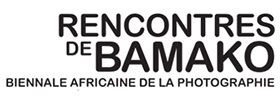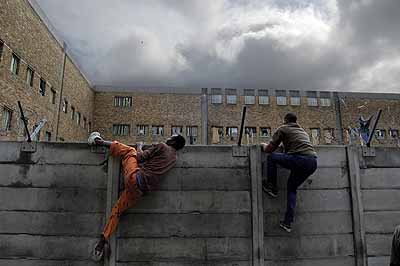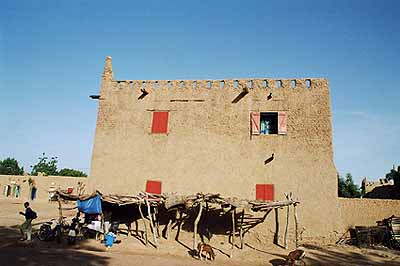
Another World - 6th African Photography Encounters in Bamako
"Un autre monde" VI Rencontres africaines de la photographie de Bamako
Ahmed Omar Addow » Studio al Rashid » Gilbert Albany » Jane Alexander » Louisa Ammi » Malala Andrialavidrazana » Rui Assubuji » Hakeem b (Benyoucef) » Raymond Barthes » Sergio Belinchón » Zohra Bensemra » Maurice "B.Pellosh" Bidilou » Alain Bizos » Bleda & Rosa » David Brazier » Benyoussef Chérif » Tomas Cumbana » Emmanuel Bakary Daou » Jean-Luc de Laguarigue » Allan de Souza » Fatoumata Diabaté » Aboubacrine Diarra » Harandane Dicko » Gisèle Didi » Djoua » Calvin Dondo » Achille Django Ello » rana elnemr » Nadia Ferroukhi » Joan Fontcuberta » Cristina García Rodero » Alberto García-Alix » Yoyo Gonthier » Marisa González » Gadalla Gubara » Abbas Habiballa » Bruno Hadjih » Farida Hamak » Dorris Haron Kasco » Mohamed Yahia Iissa » Medani AA Jahouri » Uchechukwa James Iroha » Serge Emmanuel Jongué » Paul S. Kabre » Ranjith Kally » John Kiyaya » Helga Kohl » Mamadou Konaté » Jacques Kuyten » Anicet Florent Labakh » Mark Lewis » Shadley Lombard » Awa M'Bengue » Abilio Macuvele » Armand Seth Maksim » Acamo Maquinasse » Ingrid Masondo » John Mauluka » Fatima MAZMOUZ » Peter McKenzie » Nasser Medjkane » Mohamed Messara » Vincent Meurin » Tamuka Mtenga » Moataz M. Nasr » Nelson Navin » Malik Nejmi » Oupa Nkosi » Zaynab Toyosi Odunsi » Abraham Onoriode Oghobase » Emeka Okereke » Bukkie Opebiyi » Ali Mohammed Osman » Carlos Pérez Siquier » Francis Nii Obodai Provençal » Rija Randrianasolo » Mohammed Abdul Rassul » Sarah Sadki » Ouassa Pangassy Sangaré » René Paul Savignan » Usha Seejarim » Hamid Seghilani » Samir Sid » Malick Sidibé » Kasadu de Sikasso » Antoni Socías » Youssouf Sogodogo » Amadou Sow » Mikhael Subotzky » Pascale Marthine Tayou » Fouad Hamza Tibin » Joseye Tienro » Guy Tillim » Patricia K. Triki » Fatimah Tuggar » Valentin Vallhonrat » Virxilio Vieitez » Richard Lokiden Wani » Fidelis Zvomuya »
Exhibition: 10 Nov – 10 Dec 2005
Ministère de la Culture
BP 4075 Bamako

Maison Africaine de la Photographie
Bibliothèque nationale
BP 4075 Bamako
223-2294110
"ANOTHER WORLD" BY SIMON NJAMI, CHIEF CURATOR The difference between our world and a hypothetical other world is not as unbridgeable as we like to think. Indeed the sole function of the old masters of studio photography was to show us that world. By turning their sitters into icons immortalised in the permanence of setting and costume, they transformed daily reality into a unique and magical instant. Likewise the freedom expressed in photography in the years following African independence, the "twist years" as they came to be known as a result of Malick Sidibé's photographs of 1960s parties, showed us another Africa. This was an Africa which, while it did not yet exist in fact, was a dream of its youth. This glimmer of hope glimpsed in pictures of afternoons on the banks of the Niger has not died. It is still there, within reach, and only requires one to lean forward and pick it to turn it into tangible reality. For today's youth, in spite of the years gone by, still harbours the same dreams as their elders when they were young. Thus that other world may be hidden in the unexplored field of the possible, in that urge to project oneself which materialises in the sudden flash of a picture. That "flash" is to be taken here in a literal sense. It refers to the process which leads up to the materialisation of a picture. It starts as a metaphor, as unconscious matter, before becoming concrete. Novelists were the first to teach us to live with the abstraction of the images they painted, and left us to make them live, to incarnate them according to our individual sensitivities and experience. In The Palm-Wine Drinkard, Amos Tutuola has the dead and the living existing side by side, as though nothing were more natural. It is as though the subtle boundary between our world and the other world were not in physical contingencies, but in our souls. The other world is never very far away, if we bother to search for it. The entrance to Alice's Wonderland is right there at the other end of her garden, and after his journey of initiation through the world in which he encounters new customs and characters, Voltaire's Candide understands that what he must do above all is "cultivate his garden". To reach the other world is to free ourselves of our preconceived ideas and of all our fatalism. It is to free our souls of its bonds. It is to cross the invisible threshold that separates our emotions and dreams from our human condition. It is, as Rimbaud said, to sometimes "manage to see what man thought he had seen". This revelation, which Rimbaud offers us, is both objective and subjective. We all of us have a secret part of ourselves that to outsiders seems full of shadow and mystery. A stranger is the fullest expression of this otherness, because we benefit from the crutches of distance. While we sometimes find it difficult to see the magical side of things that we think we know well, we sometimes have more immediate access to different worlds when they are remote. Algeria, Sudan, Brazil and Spain are in this way, unknown places to many, and thus may conjure up this feeling of travelling to another world. The removal is cultural and historical, a contextual removal that enables us to reach out and touch the otherness. This same otherness expressed individually in the photographs included in the international exhibition and by all the others which, in presenting their evidence of their unique experiences, take us on a static journey that has the nature of an initiation. In this way we follow the works gathered by amateur photographers during workshops held in three African countries, whose outlook, unimpeded by any professional experience, may recall feelings and images, a way of looking at the world, that we thought we had forgotten. Just as in that song by the French rock group Téléphone that I remember called "Another world". The young musicians dreamed of a blond moon, a round earth and a productive life. If there is one wish I would like to make, it is that this sixth Encounters be even more productive than its predecessors. Simon Njami, originally from Cameroon, is a freelance curator. He is a visual arts consultant at AFAA, and is also the co-founder and editor of Revue Noire, a publishing company which published the first magazine dedicated to contemporary African art from 1990 to 2000. Since 2001 Simon Njami, whose projects take him all over the world, has been the chief curator of the African Encounters of Photography in Mali. His last exhibition, Africa Remix, has already been shown in Düsseldorf, London and Paris, and is soon to be taken to the Canary Islands, Tokyo and Johannesburg. Besides his activities as curator, Simon Njami writes about and has given many lectures on photography and contemporary art. HOMMAGES Gilbert Albany (La Réunion) [1940-2004] John Mauluka (Zimbabwe)[1932-2003] MONOGRAPHIES Dorris Haron Kasco (Côte d’Ivoire) Serge Emmanuel Jongué (Guyane) Youssouf Sogodogo (Mali) COUP DE CHAPEAU Malick Sidibé (Mali) EXPOSITION INTERNATIONALE Malala Andrialavidrazana (Madagascar) Raymond Barthes (Madagascar) Lien Botha (Afrique du Sud) Fatoumata Diabate (Mali) Aboubacrine Diarra (Mali) Arandane Dicko (Mali) Gisèle Didi (Tunisie) Achille Django Ello (Côte d’Ivoire) Rana El Nemr (Égypte) Yoyo Gonthier (La Réunion) Bruno Hadjih (Algérie) Uche James Iroha (Nigeria) Paul S. Kabre (Burkina Faso) John Kiyaya (Tanzanie) Helga Kohl (Namibie) Anicet Florent Labakh (RDC) Jacques Kuyten (La Réunion) Jean-Luc Laguarigue (La Martinique) Mark Lewis (Afrique du Sud) Shadley Lombard (Afrique du Sud) Armand Seth Maksim (Madagascar) Fatima Mazmouz (Maroc) Awa M’Bengue (Sénégal) Vincent Meurin (La Réunion) Nelson Navin (La Réunion) Malik Nejmi (Maroc) Abraham Onoriode Oghobase (Nigéria) Bukkie Opebiyi (Nigeria) Francis Nii Obodai Provençal (Ghana) Rija Randrianasolo (Madagascar) Sarah Sadki (Algérie) René Paul Savignan (La Réunion) Kasadu de Sikasso (RDC) Mikhael Subotzky (Afrique du Sud) Joseye Tienro (Mali) Patricia K. Triki (Tunisie) Zaynab Toyosi Odunsi (Nigeria) PLASTICIENS Jane Alexander (Afrique du Sud) Pascale Marthine Tayou (Cameroun) Moataz Nasr (Egypte) Allan de Souza (Kenya) AGENCE ET GALERIES Alain Bizos (France) Guy Tillim (Afrique du Sud) MÉMOIRE Ranjith Kally (Afrique du Sud) LAURÉATS 2003 Emeka Okereke (Nigeria) Fatimah Tuggar (Nigeria) MASTERCLASSES Ingrid Masondo (Afrique du Sud) Peter McKenzie (Afrique du Sud) Oupa Nkosi (Afrique du Sud) Usha Seejarim (Afrique du Sud) Fidelis Zvomuya (Zimbabwe) Emmanuel Bakary Daou (Mali) Mamadou Konaté (Mali) Ouassa Pangassy Sangaré (Mali) Amadou Sow (Mali) Rui Assubuji (Mozambique) Tomas Cumbana (Mozambique) Abilio Macuvele (Mozambique) Acamo Maquinasse (Mozambique) David Brazier (Zimbabwe) Calvin Dondo (Zimbabwe) Tamuka Mtengwa (Zimbabwe) EXPOSITIONS NATIONALES Algérie: Louisa Ammi , Zohra Bensemra , Benyoussef Chérif , Nadia Ferroukhi , Farida Hamak , Nasser Medjkane , Mohamed Messara , Hamid Seghilani , Samir Sid Soudan: Ahmed Omar Addow , Abbas Habiballa , Medani AA Jahouri , Gadalla Gubara , Mohamed Yahia Iissa , Studio al Rashid , Ali Mohammed Osman , Mohamed Abdul Rassul , Fouad Hamza Tibin , Richard Lokiden Wani , Djoua EXPOSITION PAYS INVITÉ « ESPAGNE » Alberto Garcia Alix , Sergio Belinchon , Bleda y Rosa, , Joan Fontcuberta , Marisa Gonzalez , Cristina Garcia Rodero , Carlos Pérez Siquier , Antoni Socias , Valentin Vallhonrat , Virxilio Vieitez


